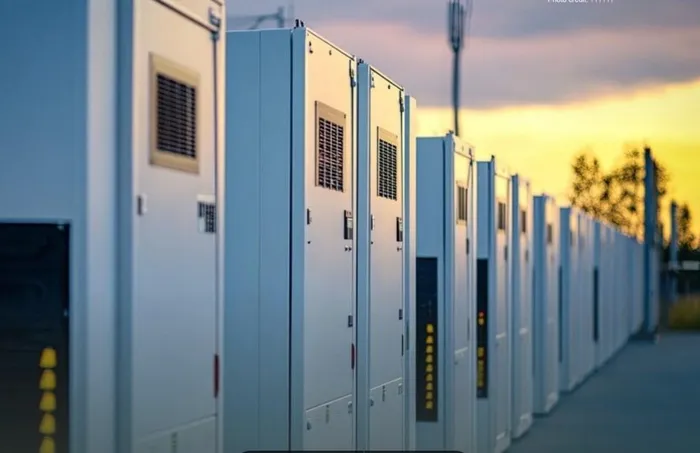South Africa poised to capitalise on global boom in Vanadium Redox Flow Batteries

Unlike conventional batteries, VRFBs separate the energy storage from the power capacity, allowing for scalable, long-duration energy storage by simply increasing tank size, resulting in a long lifespan (over 20 years), no risk of cross-contamination between electrolytes, safety (non-flammable), and the ability to remain indefinitely discharged without damage.
Image: Supplied
A new study commissioned by the Localisation Support Fund (LSF) has found that the global market for Vanadium Redox Flow Batteries (VRFBs) is on the verge of exponential growth, fuelled by the accelerating global shift toward net-zero energy systems and the increasing demand for long-duration energy storage (LDES).
VRFBs are emerging as one of the most promising technologies for long-duration energy storage — offering exceptional safety, durability, and recyclability. They deliver 10 000 to 20 000+ charge cycles and operational lifespans of 25–30 years with no degradation, even at full capacity.
Unlike lithium-ion batteries, VRFBs use a non-flammable, thermally stable electrolyte that can be reused almost indefinitely, supporting circular business models and long-term cost stability.
The study, conducted by Customised Energy Solutions (CES), projects that globally installed VRFB capacity will surge tenfold — from 4 GWh in 2024 to 40 GWh by 2030.
While growth will be modest in the short term, installations are expected to accelerate sharply from 2027, reaching 12–50 GWh annually by the end of the decade.
This expansion is set to transform the role of vanadium from a primarily metallurgical input to a key driver of the clean energy transition. According to the report, the share of vanadium used in VRFBs will jump from 5% of global demand in 2024 to nearly 27% by 2030, underpinning a doubling in total production.
“South Africa is strategically well-placed to benefit from this growth, given its significant reserves of high-grade vanadium, which are among the largest and richest in the world,” said Irshaad Kathrada, CEO of the LSF.
“The country’s recent policy alignment on critical minerals and the applicability of VRFB technology for domestic and regional energy storage applications further enhance its potential to develop a globally competitive downstream industry.”
CES forecasts that capital costs for VRFBs will fall from $380/kWh in 2025 to around $230/kWh by 2030, making them cost-competitive with lithium iron phosphate (LFP) batteries for storage durations exceeding eight hours.
Despite the technology’s promise, the study warns that the global VRFB value chain remains highly concentrated.
As of 2024, 93–95% of vanadium electrolyte manufacturing capacity is controlled by just eight producers, predominantly in China. While this concentration has enabled rapid innovation, it also exposes the market to supply risks — underscoring the need for regional diversification and new manufacturing hubs.
South Africa’s Critical Minerals and Metals Strategy, released earlier this year by the Department of Mineral and Petroleum Resources, designates vanadium as a “moderate-to-high criticality” mineral, highlighting its strategic role in the green economy.
The LSF study recommends a targeted, multi-layered policy approach to position South Africa as a VRFB manufacturing hub.
Proposed measures include establishing Energy Storage Special Economic Zones (SEZs) dedicated to battery and electrolyte production, introducing tax incentives, grants, and preferential procurement for locally produced VRFB components, and strengthening domestic demand for energy storage through public-sector and utility procurement programmes.
These recommendations are aligned with the South African Renewable Energy Masterplan (SAREM), which prioritises localisation and industrialisation across renewable energy value chains.
“Storage solutions will increasingly form a large part of the green industrial opportunity, and countries that build capability early will define the next wave of clean energy manufacturing,” Kathrada said
“South Africa has long recognised the importance of mineral beneficiation in policy — but to unlock the vanadium opportunity, we must now make the business and economic case work just as strongly. If we don’t move decisively, we risk seeing this value migrate to other global players who are acting faster.”
Echoing the LSF’s findings, Deputy Minister of Electricity and Energy, Samantha Graham-Maré, said beneficiation must form part of South Africa’s broader industrialisation vision.
“Vanadium beneficiation and VRFB manufacturing align squarely with this vision, offering an opportunity to convert our mineral wealth into sustainable jobs, exports, and technological capability,” she said.
Deputy Minister of Trade, Industry and Competition, Zuko Godlimpi, reinforced this message, highlighting the link between localisation and inclusive growth.
“Localisation is not just about producing more goods at home — it’s about building an industrial base that creates lasting jobs and competitiveness for South Africa,” Godlimpi said.
“By investing in technologies like vanadium redox flow batteries, we can turn our natural resource advantage into real industrial capability, supporting manufacturing growth and decent work across the energy value chain.”
South Africa already has a foothold in the VRFB value chain. In 2020, the Industrial Development Corporation (IDC) and Bushveld Minerals co-invested in Bushveld Electrolyte Company (BELCO) in East London — a facility designed to produce up to 8 million litres of vanadium electrolyte (200 MWh) per year.
However, financial constraints have slowed progress on the project.
Analysts say renewed investment, supported by strong policy execution, could reignite such projects and position South Africa as a key node in the global energy storage supply chain.
“We have the minerals, the expertise, and the policy framework,” said Kathrada. “Now we need coordinated action to convert these assets into industrial capability and global competitiveness.”
BUSINESS REPORT